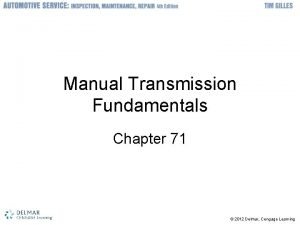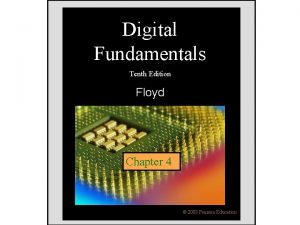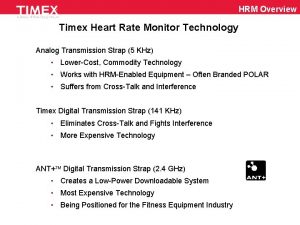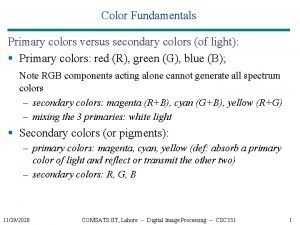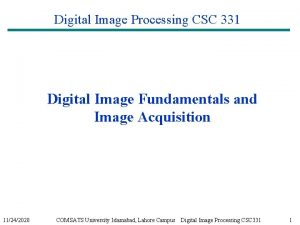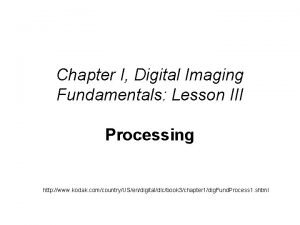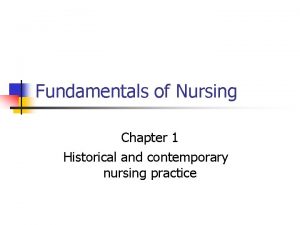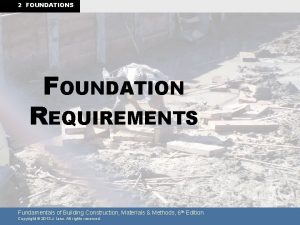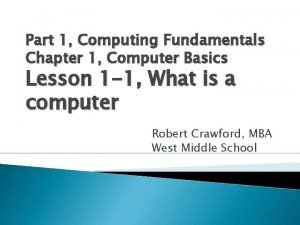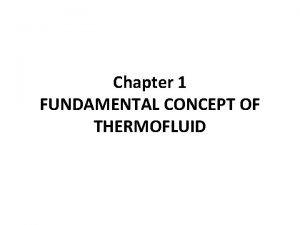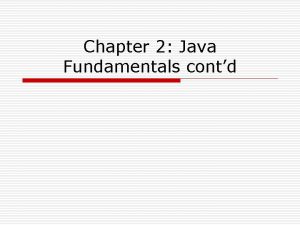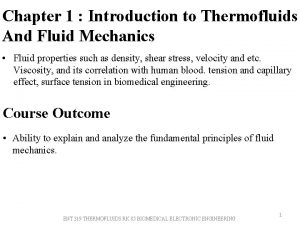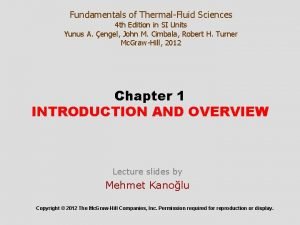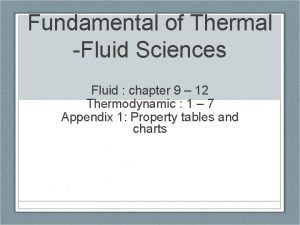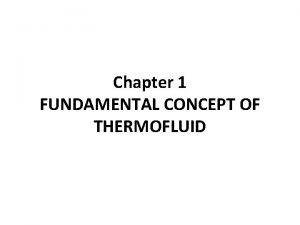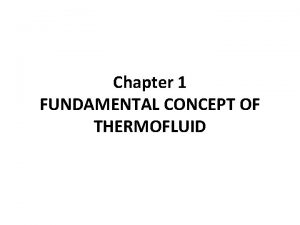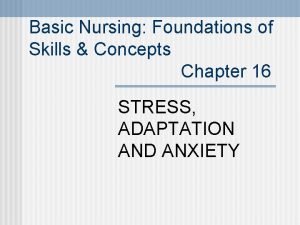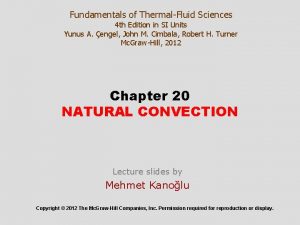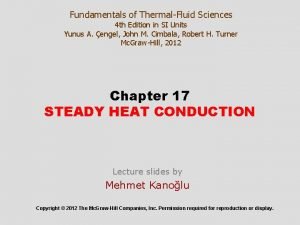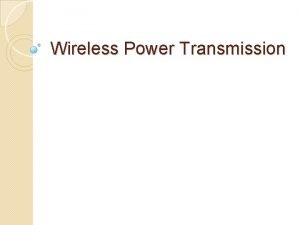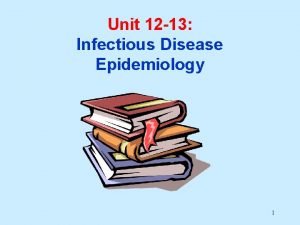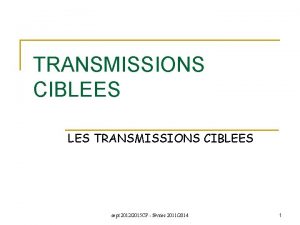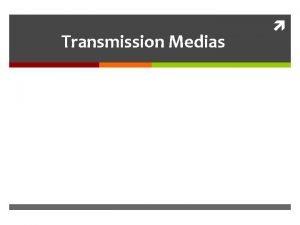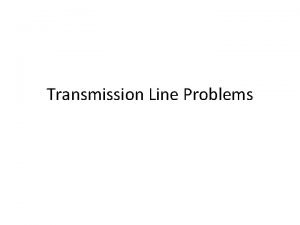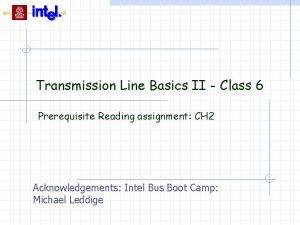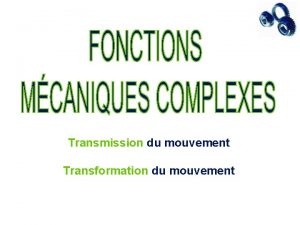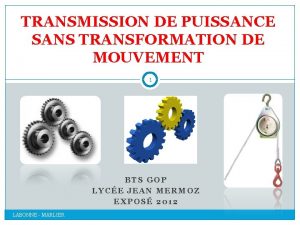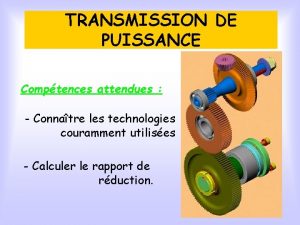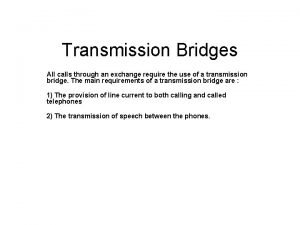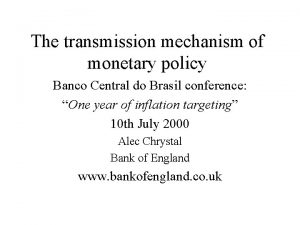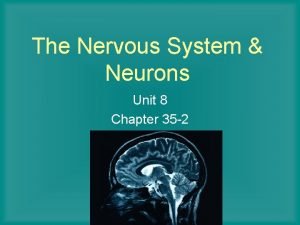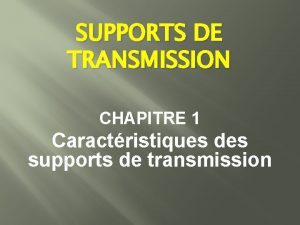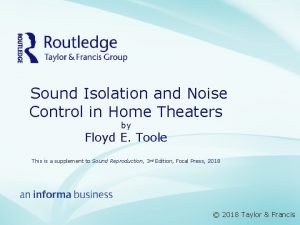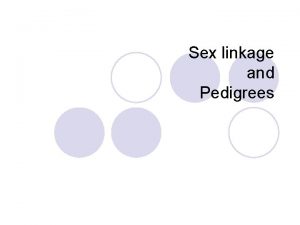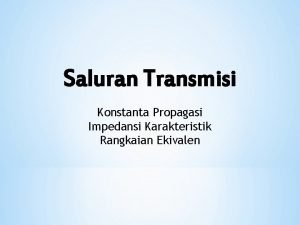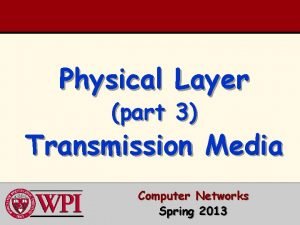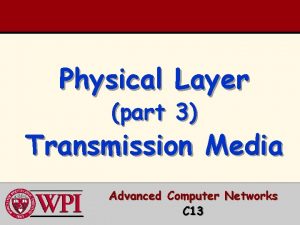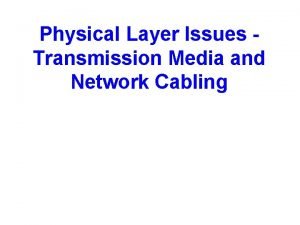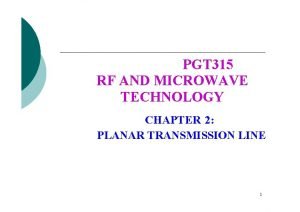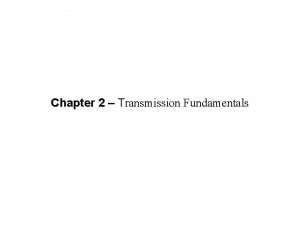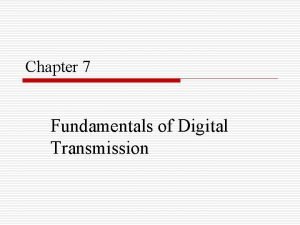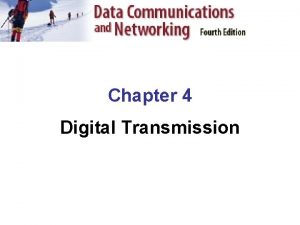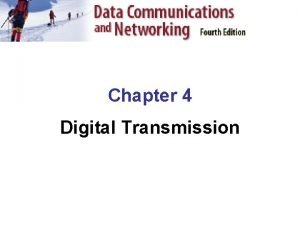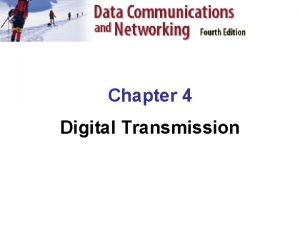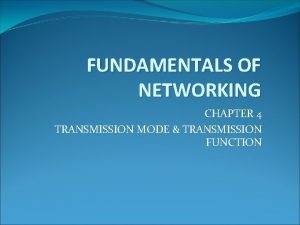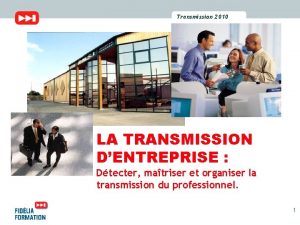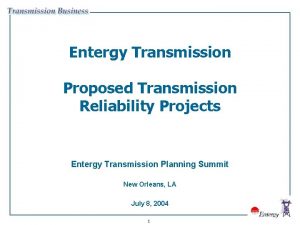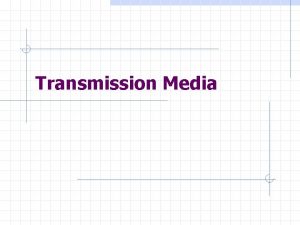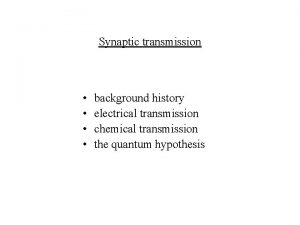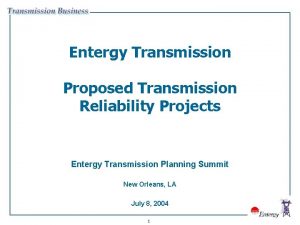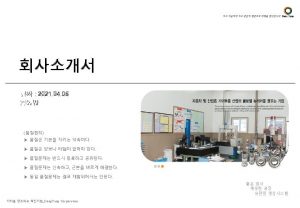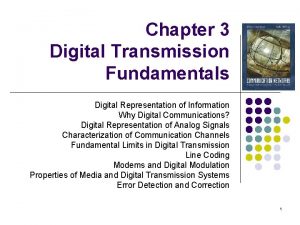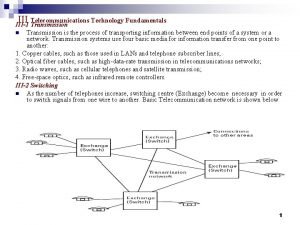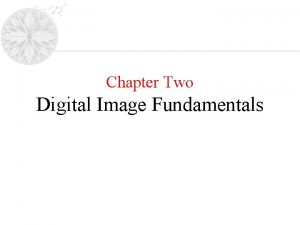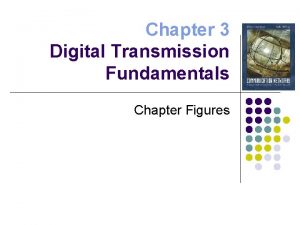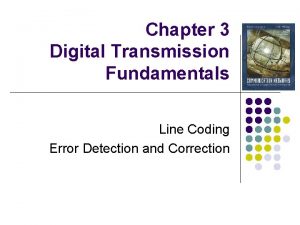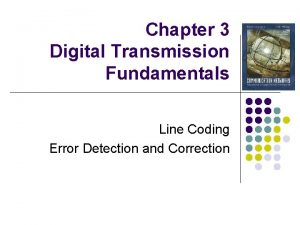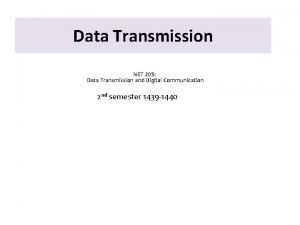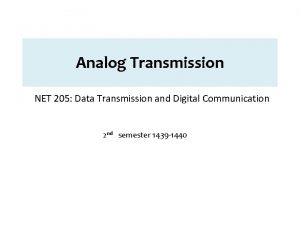Chapter 3 Digital Transmission Fundamentals 3 1 Digital













































































- Slides: 77

Chapter 3 Digital Transmission Fundamentals 3. 1 Digital Representation of Information 3. 2 Why Digital Communications? 3. 3 Digital Representation of Analog Signals 3. 4 Characterization of Communication Channels 3. 5 Fundamental Limits in Digital Transmission 3. 6 Line Coding 3. 7 Modems and Digital Modulation 3. 8 Properties of Media and Digital Transmission Systems 3. 9 Error Detection and Correction

Digital Networks l Digital transmission enables networks to support many services TV E-mail Telephone

Questions of Interest l How long will it take to transmit a message? l l l Can a network/system handle a voice (video) call? l l How many bits/second does voice/video require? At what quality? How long will it take to transmit a message without errors? l l l How many bits are in the message (text, image)? How fast does the network/system transfer information? How are errors introduced? How are errors detected and corrected? What transmission speed is possible over radio, copper cables, fiber, infrared, …?

Chapter 3 Digital Transmission Fundamentals 3. 1 Digital Representation of Information

Bits, numbers, information l Bit: number with value 0 or 1 l l n bits allows enumeration of 2 n possibilities l l n bits: digital representation for 0, 1, … , 2 n Byte or Octet, n = 8 Computer word, n = 16, 32, or 64 n-bit field in a header n-bit representation of a voice sample Message consisting of n bits The number of bits required to represent a message is a measure of its information content l More bits → More content

Block vs. Stream Information Block l Information that occurs in a single block l l l Text message Data file JPEG image MPEG file Size = bits / block or bytes/block l l l 1 Kbyte = 210 bytes 1 Mbyte = 220 bytes 1 Gbyte = 230 bytes Stream l Information that is produced & transmitted continuously l l l Real-time voice Streaming video Bit rate = bits / second l l l 1 Kbps = 103 bps 1 Mbps = 106 bps 1 Gbps = 109 bps

Transmission Delay l l l L R bps L/R d c tprop number of bits in message speed of digital transmission system time to transmit the information distance in meters speed of light (3 x 108 m/s in vacuum) time for signal to propagate across medium Delay = tprop + L/R = d/c + L/R seconds What can be done to reduce the delay? l Use data compression to reduce L l Use higher-speed modem to increase R l Place server closer to reduce d

Compression l l Information usually not represented efficiently Data compression algorithms l l Represent the information using fewer bits Noiseless: original information recovered exactly l l Noisy: recover information approximately l l l e. g. , zip, compress, GIF, fax JPEG Tradeoff: # bits vs. quality Compression Ratio #bits (original file) / #bits (compressed file)

Color Image W H Color image = H W W W Red component image Green component image Blue component image + H Total bits = 3 H W pixels B bits/pixel = 3 HWB bits Example: 8 10 inch picture at 400 pixels per inch 2 400 8 10 = 12. 8 million pixels 8 bits/pixel/color 12. 8 megapixels 3 bytes/pixel = 38. 4 megabytes

Examples of Block Information Type Method Format Original Compressed (Ratio) Text Zip, compress ASCII Kbytes. Mbytes (2 -6) Fax CCITT Group 3 A 4 page 200 x 100 pixels/in 2 256 Kbytes 5 -54 Kbytes (5 -50) JPEG 8 x 10 in 2 photo 4002 pixels/in 2 38. 4 Mbytes 1 -8 Mbytes (5 -30) Color Image

Stream Information l l A real-time voice signal must be digitized & transmitted as it is produced Analog signal level varies continuously in time Th e s p ee ch s i g n al l e v el v a r ie s w i th t i m(e)

Digitization of Analog Signal l Sample analog signal in time and amplitude Find closest approximation Original signal Sample value 3 bits / sample l 7 D/2 5 D/2 3 D/2 Approximation -D/2 -3 D/2 -5 D/2 -7 D/2 Rs = Bit rate = # bits/sample x # samples/second

Bit Rate of Digitized Signal l Bandwidth Ws Hertz: how fast the signal changes l l l Higher bandwidth → more frequent samples Minimum sampling rate = 2 x Ws Representation accuracy: range of approximation error Higher accuracy → smaller spacing between approximation values → more bits per sample l

Example: Voice & Audio Telephone voice l Ws = 4 k. Hz → 8000 samples/sec l 8 bits/sample l Rs=8 x 8000 = 64 kbps l Cellular phones use more powerful compression algorithms: 8 -12 kbps CD Audio l Ws = 22 k. Hz → 44000 samples/sec l 16 bits/sample l Rs=16 x 44000= 704 kbps per audio channel l MP 3 uses more powerful compression algorithms: 50 kbps per audio channel

Video Signal l Sequence of picture frames l l Frame repetition rate l l Each picture digitized & compressed 10 -30 -60 frames/second depending on quality Frame resolution l l l Small frames for videoconferencing Standard frames for conventional broadcast TV HDTV frames 30 fps Rate = M bits/pixel x (W x H) pixels/frame x F frames/second

Video Frames 176 QCIF videoconferencing at 30 frames/sec = 144 (144 lines and 176 pixels per line ) 760, 000 pixels/sec 720 Broadcast TV 480 at 30 frames/sec = 10. 4 x 106 pixels/sec 1920 HDTV at 30 frames/sec = 1080 67 x 106 pixels/sec

Digital Video Signals Type Method Format Original Compressed Video Conference H. 261 176 x 144 or 352 x 288 pix @10 -30 fr/sec 2 -36 Mbps 64 -1544 kbps Full Motion MPEG 2 720 x 480 pix @30 fr/sec 249 Mbps 2 -6 Mbps HDTV MPEG 2 1920 x 1080 pix @30 fr/sec 1. 6 Gbps 19 -38 Mbps

Transmission of Stream Information l Constant bit-rate l l l Signals such as digitized telephone voice produce a steady stream: e. g. , 64 kbps Network must support steady transfer of signal, e. g. , 64 kbps circuit Variable bit-rate l l Signals such as digitized video produce a stream that varies in bit rate, e. g. , according to motion and detail in a scene Network must support variable transfer rate of signal, e. g. , packet switching or rate-smoothing with constant bit-rate circuit

Stream Service Quality Issues l Network Transmission Impairments l l Delay: Is information delivered in timely fashion? Jitter: Is information delivered in sufficiently smooth fashion? Loss: Is information delivered without loss? If loss occurs, is delivered signal quality acceptable? Applications & application layer protocols developed to deal with these impairments

Chapter 3 Communication Networks and Services 3. 2 Why Digital Communications?

A Transmission System Transmitter Receiver Communication channel Transmitter l Converts information into signal suitable for transmission l Injects energy into communications medium or channel l l Telephone converts voice into electric current Modem converts bits into tones Receiver l Receives energy from medium l Converts received signal into form suitable for delivery to user l l Telephone converts current into voice Modem converts tones into bits

Transmission Impairments Transmitter Transmitted Signal Receiver Communication channel Communication Channel Transmission Impairments l Pair of copper wires l Signal attenuation l Coaxial cable l Signal distortion l Radio l Spurious noise l Light in optical fiber l Interference from other signals l Light in air l Infrared

Analog Long-Distance Communications Transmission segment Source l l l . . . Repeater Destination Each repeater attempts to restore analog signal to its original form Restoration is imperfect l l Repeater Distortion is not completely eliminated Noise & interference is only partially removed Signal quality decreases with # of repeaters Communications is distance-limited Still used in analog cable TV systems Analogy: Copy a song using a cassette recorder

Analog vs. Digital Transmission Analog transmission: all details must be reproduced accurately Sent Distortion Attenuation Received Digital transmission: only discrete levels need to be reproduced Sent Distortion Attenuation Received Simple Receiver: Was original pulse positive or negative?

Digital Long-Distance Communications Transmission segment Source l l l Regenerator . . . Regenerator Destination Regenerator recovers original data sequence and retransmits on next segment Can design it so error probability is very small Then each regeneration is like the first time! Analogy: copy an MP 3 file Communications is possible over very long distances Digital systems vs. analog systems l l Less power, longer distances, lower system cost Monitoring, multiplexing, coding, encryption, protocols…

Digital Binary Signal 1 +A 0 -A 0 T 1 2 T 1 3 T 0 4 T 5 T 1 6 T Bit rate = 1 bit / T seconds For a given communications medium: l How do we increase transmission speed? l How do we achieve reliable communications? l Are there limits to speed and reliability?

Pulse Transmission Rate l Objective: Maximize pulse rate through a channel, that is, make T as small as possible Channel T t t If input is a narrow pulse, then typical output is a spread-out pulse with ringing l Question: How frequently can these pulses be transmitted without interfering with each other? l Answer: 2 x Wc pulses/second where Wc is the bandwidth of the channel l

Bandwidth of a Channel X(t) = a cos(2 pft) l Y(t) = A(f) a cos(2 pft) If input is sinusoid of frequency f, then l l l Channel output is a sinusoid of same frequency f Output is attenuated by an amount A(f) that depends on f A(f)≈1, then input signal passes readily A(f)≈0, then input signal is blocked Bandwidth Wc is the range of frequencies passed by channel A(f) 1 0 Wc f Ideal low-pass channel

Multilevel Pulse Transmission Assume channel of bandwidth Wc, and transmit 2 Wc pulses/sec (without interference) l If pulses amplitudes are either -A or +A, then each pulse conveys 1 bit, so Bit Rate = 1 bit/pulse x 2 Wc pulses/sec = 2 Wc bps l If amplitudes are from {-A, -A/3, +A}, then bit rate is 2 x 2 Wc bps l By going to M = 2 m amplitude levels, we achieve Bit Rate = m bits/pulse x 2 Wc pulses/sec = 2 m. Wc bps l In the absence of noise, the bit rate can be increased without limit by increasing m

Noise & Reliable Communications l All physical systems have noise l l l Electrons always vibrate at non-zero temperature Motion of electrons induces noise Presence of noise limits accuracy of measurement of received signal amplitude Errors occur if signal separation is comparable to noise level Bit Error Rate (BER) increases with decreasing signal-to-noise ratio Noise places a limit on how many amplitude levels can be used in pulse transmission

Signal-to-Noise Ratio Signal + noise Noise High SNR t t t No errors Noise Signal + noise Low SNR t SNR = t t Average signal power Average noise power SNR (d. B) = 10 log 10 SNR error

Shannon Channel Capacity C = Wc log 2 (1 + SNR) bps l l l Arbitrarily reliable communications is possible if the transmission rate R < C. If R > C, then arbitrarily reliable communications is not possible. “Arbitrarily reliable” means the BER can be made arbitrarily small through sufficiently complex coding. C can be used as a measure of how close a system design is to the best achievable performance. Bandwidth Wc & SNR determine C

Example l Find the Shannon channel capacity for a telephone channel with Wc = 3400 Hz and SNR = 10000 C = 3400 log 2 (1 + 10000) = 3400 log 10 (10001)/log 102 = 45200 bps Note that SNR = 10000 corresponds to SNR (d. B) = 10 log 10(10001) = 40 d. B

Bit Rates of Digital Transmission Systems System Bit Rate Observations Telephone twisted pair 33. 6 -56 kbps 4 k. Hz telephone channel Ethernet twisted pair 10 Mbps, 100 Mbps, 1 Gbps 100 meters of unshielded twisted copper wire pair Cable modem 500 kbps-4 Mbps Shared CATV return channel ADSL Coexists with analog telephone signal 64 -640 kbps in, 1. 5366. 144 Mbps out 2. 4 GHz radio 2 -11 Mbps IEEE 802. 11 wireless LAN 28 GHz radio 1. 5 -45 Mbps 5 km multipoint radio Optical fiber 2. 5 -10 Gbps 1 wavelength Optical fiber >1600 Gbps Many wavelengths

Examples of Channels Channel Telephone voice channel Copper pair Coaxial cable 5 GHz radio (IEEE 802. 11) Optical fiber Bandwidth Bit Rates 3 k. Hz 33 kbps 1 MHz 1 -6 Mbps 500 MHz (6 MHz channels) 300 MHz (11 channels) Many Tera. Hertz 30 Mbps/ channel 54 Mbps / channel 40 Gbps / wavelength

Chapter 3 Digital Transmission Fundamentals 3. 9 Error Detection and Correction

Error Control l l Digital transmission systems introduce errors Applications require certain reliability level l l Data applications require error-free transfer Voice & video applications tolerate some errors Error control used when transmission system does not meet application requirement Error control ensures a data stream is transmitted to a certain level of accuracy despite errors Two basic approaches: l Error detection & retransmission (ARQ) l Forward error correction (FEC)

Key Idea l l All transmitted data blocks (“codewords”) satisfy a pattern If received block doesn’t satisfy pattern, it is in error Redundancy: only a subset of all possible blocks can be codewords Blindspot: when channel transforms a codeword into another codeword All inputs to channel satisfy pattern or condition User Encoder information Channel output Pattern checking Deliver user information or set error alarm

Single Parity Check l Append an overall parity check to k information bits Info Bits: Check Bit: Codeword: l l bk+1= b 1+ b 2+ b 3+ …+ bk modulo 2 (b 1, b 2, b 3, …, bk, , bk+!) All codewords have even # of 1 s Receiver checks to see if # of 1 s is even l l l b 1, b 2, b 3, …, bk All error patterns that change an odd # of bits are detectable All even-numbered patterns are undetectable Parity bit used in ASCII code

Example of Single Parity Code l Information (7 bits): (0, 1, 1, 0, 0) Parity Bit: b 8 = 0 + 1 +1 + 0 = 1 Codeword (8 bits): (0, 1, 1, 0, 0, 1) l If single error in bit 3 : (0, 1, 1, 0, 0, 1) l l l # of 1’s =5, odd Error detected If errors in bits 3 and 5: (0, 1, 1, 1, 0, 0, 0, 1) l l # of 1’s =4, even Error not detected

Check bits & Error Detection Received information bits Information bits Recalculate check bits Calculate check bits Channel Sent check bits n – k bits Received check bits Compare Information accepted if check bits match

How good is the single parity check code? l l Redundancy: Single parity check code adds 1 redundant bit per k information bits: overhead = 1/(k + 1) Coverage: all error patterns with odd # of errors can be detected l l An error pattern is a binary (k + 1)-tuple with 1 s where errors occur and 0’s elsewhere Of 2 k+1 binary (k + 1)-tuples, ½ are odd, so 50% of error patterns can be detected Is it possible to detect more errors if we add more check bits? Yes, with the right codes

What if bit errors are random? l l Many transmission channels introduce bit errors at random, independently of each other, and with probability p Some error patterns are more probable than others: p and 1–p 2 6 8 P[11000000] = p (1 – p) = (1 – p) 1–p P[10000000] = p(1 – p)7 = (1 – p)8 l l l In any worthwhile channel p < 0. 5, and so (p/(1 – p) < 1 It follows that patterns with 1 error are more likely than patterns with 2 errors and so forth What is the probability that an undetectable error pattern occurs?

Single parity check code with random bit errors l Undetectable error pattern if even # of bit errors: P[error detection failure] = P[undetectable error pattern] = P[error patterns with even number of 1 s] = l n 2 p (1 – p)n-2 + 2 n 4 p 4(1 – p)n-4 + … Example: Evaluate above for n = 32, p = 10 -3 P[undetectable error] = 32 32 (10 -3)2 (1 – 10 -3)30 + (10 -3)4 (1 – 10 -3)28 2 4 ≈ 496 (10 -6) + 35960 (10 -12) ≈ 4. 96 (10 -4) l For this example, roughly 1 in 2000 error patterns is undetectable

What is a good code? l l Many channels have preference for error patterns that have fewer # of errors These error patterns map transmitted codeword to nearby n-tuple If codewords close to each other then detection failures will occur Good codes should maximize separation between codewords o o x x x o o o Poor distance properties x = codewords o = noncodewords o x x o o o x x Good distance properties

Two-Dimensional Parity Check l l l More parity bits to improve coverage Arrange information as columns Add single parity bit to each column Add a final “parity” column Used in early error control systems 1 0 0 0 1 Last column consists 1 0 0 of check bits for each 1 1 0 row 1 0 0 1 1 1 Bottom row consists of check bit for each column

Error-detecting capability 1 0 0 0 0 0 0 0 1 1 0 0 One error 1 0 0 1 1 0 0 1 1 1 1 0 0 1 0 0 0 1 1 0 0 Three errors 1 0 0 1 0 0 1 1 1 1 0 0 0 1 0 Arrows indicate failed check bits Two errors 1, 2, or 3 errors can always be detected; Not all patterns >4 errors can be detected Four errors (undetectable)

Other Error Detection Codes l l l Many applications require very low error rate Need codes that detect the vast majority of errors Single parity check codes do not detect enough errors Two-dimensional codes require too many check bits The following error detecting codes used in practice: l Internet Check Sums l CRC Polynomial Codes

Internet Checksum l l l Several Internet protocols (e. g. , IP, TCP, UDP) use check bits to detect errors in the IP header (or in the header and data for TCP/UDP) A checksum is calculated for header contents and included in a special field. Checksum recalculated at every router, so algorithm selected for ease of implementation in software Let header consist of L, 16 -bit words, b 0, b 1, b 2, . . . , b. L-1 The algorithm appends a 16 -bit checksum b. L

Checksum Calculation The checksum b. L is calculated as follows: l Treating each 16 -bit word as an integer, find x = b 0 + b 1 + b 2+. . . + b. L-1 modulo 216 -1 l The checksum is then given by: b. L = - x modulo 216 -1 Thus, the headers must satisfy the following pattern: 0 = b 0 + b 1 + b 2+. . . + b. L-1 + b. L modulo 216 -1 l The checksum calculation is carried out in software using one’s complement arithmetic

Internet Checksum Example Use Modulo Arithmetic l Assume 4 -bit words l Use mod 24 -1 arithmetic l b 0=1100 = 12 l b 1=1010 = 10 l b 0+b 1=12+10=7 mod 15 l b 2 = -7 = 8 mod 15 l Therefore l b 2=1000 Use Binary Arithmetic l Note 16 =1 mod 15 l So: 10000 = 0001 mod 15 l leading bit wraps around b 0 + b 1 = 1100+1010 =10110 =10000+0110 =0001+0110 =0111 =7 Take 1 s complement b 2 = -0111 =1000

Polynomial Codes l l l Polynomials instead of vectors for codewords Polynomial arithmetic instead of check sums Implemented using shift-register circuits Also called cyclic redundancy check (CRC) codes Most data communications standards use polynomial codes for error detection Polynomial codes is the basis for powerful error-correction methods

Binary Polynomial Arithmetic l Binary vectors map to polynomials (ik-1 , ik-2 , …, i 2 , i 1 , i 0) ik-1 xk-1 + ik-2 xk-2 + … + i 2 x 2 + i 1 x + i 0 Addition: (x 7 + x 6 + 1) + (x 6 + x 5) = x 7 + x 6 + x 5 + 1 = x 7 +(1+1)x 6 + x 5 + 1 = x 7 +x 5 + 1 since 1+1=0 mod 2 Multiplication: (x + 1) (x 2 + x + 1) = x(x 2 + x + 1) + 1(x 2 + x + 1) = x 3 + x 2 + x + (x 2 + x + 1) = x 3 + 1

Binary Polynomial Division with Decimal Numbers 34 35 ) 1222 105 divisor 17 2 140 32 l quotient dividend = quotient x divisor +remainder 1222 = 34 x 35 + 32 remainder Polynomial Division divisor x 3 + x 2 + x = q(x) quotient x 3 + x + 1 ) x 6 + x 5 x 6 + x 4 + x 3 Note: Degree of r(x) is less than degree of divisor dividend x 5 + x 4 + x 3 x 5 + x 3 + x 2 x 4 + x 2 + x x = r(x) remainder

Polynomial Coding l Code has binary generating polynomial of degree n–k l g(x) = xn-k + gn-k-1 xn-k-1 + … + g 2 x 2 + g 1 x + 1 k information bits define polynomial of degree k – 1 i(x) = ik-1 xk-1 + ik-2 xk-2 + … + i 2 x 2 + i 1 x + i 0 l Find remainder polynomial of at most degree n – k – 1 l q(x) xn-ki(x) = q(x)g(x) + r(x) g(x) ) xn-k i(x) r(x) Define the codeword polynomial of degree n – 1 b(x) = xn-ki(x) + r(x) n bits k bits n-k bits

Polynomial example: k = 4, n–k = 3 Generator polynomial: g(x)= x 3 + x + 1 Information: (1, 1, 0, 0) i(x) = x 3 + x 2 Encoding: x 3 i(x) = x 6 + x 5 x 3 + x 2 + x x 3 + x + 1 ) x 6 + x 5 x 6 + 1110 1011 ) 1100000 1011 x 4 + x 3 1110 1011 x 5 + x 4 + x 3 x 5 + x 3 + x 2 x 4 + x 2 + x x Transmitted codeword: b(x) = x 6 + x 5 + x b = (1, 1, 0, 0, 0, 1, 0) 1010 1011 010

Exercise 1 Generator polynomial: g(x)= x 3 + x 2 + 1 Information: (1, 0, 1, 1, 0) i(x) = x 6 + x 4 + x 2 + x Q 1: Find the remainder (also called Frame Check Sequence, FCS) and transmitted codeword Encoding: x 3 i(x) = x 3 (x 6 + x 4 + x 2 + x) = x 9 + x 7 + x 5 + x 3

Solution Remainder? 001 Transmitted codeword: b(x) = x 9 + x 7 + x 5 + x 3 + 1 b = (1, 0, 1, 1, 0, 0, 0, 1)

The Pattern in Polynomial Coding l All codewords satisfy the following pattern: b(x) = xn-ki(x) + r(x) = q(x)g(x) l l l All codewords are a multiple of g(x) Receiver should divide received n-tuple by g(x) and check if remainder is zero If remainder is nonzero, then received n-tuple is not a codeword

Exercise 1 cont’d Q 2: How does the receiver check whether the message T was transmitted without any errors? Show your work Answer: The received message b is divided by g(x) and if the remainder is zero then b is error-free otherwise it contains errors.

Shift-Register Implementation 1. 2. 3. 4. Accept information bits ik-1, ik-2, …, i 2, i 1, i 0 Append n – k zeros to information bits Feed sequence to shift-register circuit that performs polynomial division After n shifts, the shift register contains the remainder

Division Circuit Encoder for g(x) = x 3 + x + 1 0, 0, 0, i 1, i 2, i 3 Clock 0 1 2 3 4 5 6 7 g 0 = 1 + Input 1 = i 3 1 = i 2 0 = i 1 0 = i 0 0 Check bits: g 1 = 1 Reg 0 0 1 1 1 0 r 0 = 0 r(x) = x + g 3 = 1 Reg 1 0 0 1 1 1 0 0 1 r 1 = 1 Reg 2 0 0 0 1 1 1 0 0 r 2 = 0

Undetectable error patterns (Transmitter) b(x) (Receiver) + R(x)=b(x)+e(x) (Channel) e(x) Error polynomial l l e(x) has 1 s in error locations & 0 s elsewhere Receiver divides the received polynomial R(x) by g(x) Blindspot: If e(x) is a multiple of g(x), that is, e(x) is a nonzero codeword, then R(x) = b(x) + e(x) = q(x)g(x) + q’(x)g(x) The set of undetectable error polynomials is the set of nonzero code polynomials Choose the generator polynomial so that selected error patterns can be detected.

Designing good polynomial codes l l Select generator polynomial so that likely error patterns are not multiples of g(x) Detecting Single Errors l l l e(x) = xi for error in location i + 1 If g(x) has more than 1 term, it cannot divide xi Detecting Double Errors l l e(x) = xi + xj = xi(xj-i+1) where j>i If g(x) has more than 1 term, it cannot divide xi If g(x) is a primitive polynomial, it cannot divide xm+1 for all m<2 n-k-1 (Need to keep codeword length less than 2 n-k-1) Primitive polynomials can be found by consulting coding theory books

Designing good polynomial codes l Detecting Odd Numbers of Errors l l l Suppose all codeword polynomials have an even # of 1 s, then all odd numbers of errors can be detected As well, b(x) evaluated at x = 1 is zero because b(x) has an even number of 1 s This implies x + 1 must be a factor of all b(x) Pick g(x) = (x + 1) p(x) where p(x) is primitive Visit http: //mathworld. wolfram. com/Primitive. Polynomial. html for more info on primitive polynomials

Standard Generator Polynomials CRC = cyclic redundancy check l CRC-8: = x 8 + x 2 + x + 1 l CRC-16: = x 16 + x 15 + x 2 + 1 = (x + 1)(x 15 + x + 1) l Bisync CCITT-16: = x 16 + x 12 + x 5 + 1 l ATM CCITT-32: HDLC, XMODEM, V. 41 IEEE 802, Do. D, V. 42 = x 32 + x 26 + x 23 + x 22 + x 16 + x 12 + x 11 + x 10 + x 8 + x 7 + x 5 + x 4 + x 2 + x + 1

Hamming Codes l l Class of error-correcting codes Can detect single and double-bit errors Can correct single-bit errors For each m > 2, there is a Hamming code of length = 2 m – 1 with n – k = m parity check bits Redundancy m 3 4 5 6 n = 2 m– 1 k = n–m 7 4 15 11 31 26 63 57 m/n 3/7 4/15 5/31 6/63 n

m = 3 Hamming Code l l Information bits are b 1, b 2, b 3, b 4 Equations for parity checks b 5, b 6, b 7 b 5 = b 1 + b 3 + b 4 b 6 = b 1 + b 2 b 7 = l l + b 4 + b 2 + b 3 + b 4 There are 24 = 16 codewords (0, 0, 0, 0) is a codeword

Hamming (7, 4) code l l Hamming code really refers to a specific (7, 4) code Hamming introduced in 1950 Hamming code adds 3 additional check bits to every 4 data bits of the message for a total of 7 Hamming's (7, 4) code can correct any single-bit error, and detect all two-bit errors Since the medium would have to be uselessly noisy for 2 out of 7 bits (about 30%) to be lost, Hamming's (7, 4) is effectively lossless

Hamming (7, 4) code Information Codeword Weight b 1 b 2 b 3 b 4 b 5 b 6 b 7 w(b) b 1 b 2 b 3 b 4 0 0 0 0 1 0 0 0 1 1 4 0 0 1 0 1 0 1 3 0 0 1 1 0 1 0 3 0 1 0 0 0 1 1 3 0 1 0 1 1 0 0 3 0 1 1 0 4 0 1 1 1 0 0 1 4 1 0 0 0 1 1 0 3 1 0 0 1 3 1 0 1 0 0 1 1 4 1 0 1 1 1 0 0 4 1 1 0 0 1 0 1 4 1 1 0 1 0 1 0 4 1 1 1 0 0 0 0 3 1 1 1 7

Parity Check Equations l Rearrange parity check equations: 0 = b 5 + b 5 = b 1 + b 3 + b 4 + b 5 0 = b 6 + b 6 = b 1 + b 2 0 = b 7 + b 7 = l In matrix form: + b 4 + b 6 + b 2 + b 3 + b 4 + b 7 b 1 b 2 0 = 1011100 b 3 0 = 1101010 b 4 = H bt = 0 0 = 0111001 b 5 b 6 b 7 l l All codewords must satisfy these equations Note: each nonzero 3 -tuple appears once as a column in check matrix H

Error Detection with Hamming Code 1011100 s=He= 1101010 0111001 0 0 0 0 0 1 1 1 0 0 1 Single error detected = 0 1 0 1 = 1 + 0 1 = 1 1 0 1 1 + 0 = 0 1 1 Double error detected Triple error not detected

Hamming Distance (weight) l l is the # of positions in two strings of equal length for which the corresponding elements are different (i. e. , the # of substitutions required to change one into the other) For example: l l Hamming distance between 1011101 and 1001001 is 2. Hamming distance between 2143896 and 2233796 is 3. Hamming distance between "toned" and "roses" is 3. The Hamming weight of a string is its Hamming distance from the zero string of the same length l l it is the number of elements in the string which are not zero for a binary string this is just the number of 1's, so for instance the Hamming weight of 11101 is 4.

General Hamming Codes l For m > 2, the Hamming code is obtained through the check matrix H: l l l Each nonzero m-tuple appears once as a column of H The resulting code corrects all single errors For each value of m, there is a polynomial code with g(x) of degree m that is equivalent to a Hamming code and corrects all single errors l For m = 3, g(x) = x 3+x+1

Error-correction using Hamming Codes (Transmitter) b + R (Receiver) e Error pattern l l l The receiver first calculates the syndrome s: s = HR = H (b + e) = Hb + He = He If s = 0, then the receiver accepts R as the transmitted codeword If s is nonzero, then an error is detected l l l Hamming decoder assumes a single error has occurred Each single-bit error pattern has a unique syndrome The receiver matches the syndrome to a single-bit error pattern and corrects the appropriate bit

Performance of Hamming Error. Correcting Code l Assume bit errors occur independent of each other and with probability p s = H R = He 7 p s=0 No errors in transmission (1–p)7 Undetectable errors 7 p 3 s=0 1– 3 p Correctable errors 7 p(1– 3 p) 3 p Uncorrectable errors 21 p 2

History of Hamming Code l Read http: //en. wikipedia. org/wiki/Hamming_code
 Describe manual transmission fundamentals.
Describe manual transmission fundamentals. Digital fundamentals chapter 4
Digital fundamentals chapter 4 Digital transmission advantages and disadvantages
Digital transmission advantages and disadvantages Digital data transmission
Digital data transmission Digital vs analog transmission
Digital vs analog transmission Analog and digital signals in computer networking
Analog and digital signals in computer networking Timex digital heart rate monitor
Timex digital heart rate monitor Digital fundamentals floyd ppt
Digital fundamentals floyd ppt Thomas l floyd digital fundamentals 10th edition
Thomas l floyd digital fundamentals 10th edition Color fundamentals in digital image processing
Color fundamentals in digital image processing Digital fundamentals 10th edition
Digital fundamentals 10th edition Digital fundamentals answers
Digital fundamentals answers Color
Color Fundamentals of digital imaging
Fundamentals of digital imaging Puncture resistant container
Puncture resistant container Chapter 19 disease transmission and infection prevention
Chapter 19 disease transmission and infection prevention Chapter 15:4 observing standard precautions
Chapter 15:4 observing standard precautions Chapter 19 disease transmission and infection prevention
Chapter 19 disease transmission and infection prevention Fundamentals chapter 1
Fundamentals chapter 1 Fundamentals of electric circuits chapter 4 solutions
Fundamentals of electric circuits chapter 4 solutions Fundamentals of corporate finance chapter 6 solutions
Fundamentals of corporate finance chapter 6 solutions Conceptual physics magnetism
Conceptual physics magnetism Tire wheel and wheel bearing fundamentals
Tire wheel and wheel bearing fundamentals Understanding your health and wellness
Understanding your health and wellness 9
9 Fundamentals of electric circuits chapter 7 solutions
Fundamentals of electric circuits chapter 7 solutions Fundamentals of building construction chapter summaries
Fundamentals of building construction chapter summaries Chapter 1 computer fundamentals
Chapter 1 computer fundamentals Fundamentals of corporate finance, chapter 1
Fundamentals of corporate finance, chapter 1 Fundamentals of thermal-fluidsciences chapter 1 problem 25p
Fundamentals of thermal-fluidsciences chapter 1 problem 25p Fundamentals of information systems chapter 1
Fundamentals of information systems chapter 1 Fundamental of information system
Fundamental of information system Fundamentals of nursing chapter 17 vital signs
Fundamentals of nursing chapter 17 vital signs Chapter 6 fingerprints
Chapter 6 fingerprints Lodging operation
Lodging operation Chapter 2 lab java fundamentals
Chapter 2 lab java fundamentals Back channeling nursing
Back channeling nursing Fundamentals of thermal-fluidsciences chapter 1 problem 9p
Fundamentals of thermal-fluidsciences chapter 1 problem 9p Chapter 39 electrical fundamentals
Chapter 39 electrical fundamentals Fundamentals of thermal-fluidsciences chapter 2 problem 12p
Fundamentals of thermal-fluidsciences chapter 2 problem 12p Fundamentals of thermal-fluidsciences chapter 2 problem 58p
Fundamentals of thermal-fluidsciences chapter 2 problem 58p Chapter 15 critical thinking in nursing practice
Chapter 15 critical thinking in nursing practice Glencoe health chapter 1 understanding health and wellness
Glencoe health chapter 1 understanding health and wellness Fundamentals of thermal-fluidsciences chapter 1 problem 19p
Fundamentals of thermal-fluidsciences chapter 1 problem 19p Fundamentals of thermal-fluidsciences chapter 1 problem 1p
Fundamentals of thermal-fluidsciences chapter 1 problem 1p Fundamentals of nursing chapter 16
Fundamentals of nursing chapter 16 Grashoff number
Grashoff number Fundamentals of corporate finance, chapter 1
Fundamentals of corporate finance, chapter 1 Fundamentals of thermal-fluidsciences chapter 2 problem 30p
Fundamentals of thermal-fluidsciences chapter 2 problem 30p Fundamentals of thermal-fluidsciences chapter 2 problem 27p
Fundamentals of thermal-fluidsciences chapter 2 problem 27p Chapter 23 computer system fundamentals
Chapter 23 computer system fundamentals Air ionization in wireless power transmission
Air ionization in wireless power transmission Wireless power transmission project report doc
Wireless power transmission project report doc Communication theory tutor
Communication theory tutor Infectivity definition
Infectivity definition Mtved ifsi
Mtved ifsi Guided media
Guided media Transmission line example problems
Transmission line example problems Transmission line examples
Transmission line examples Système de transmission du mouvement
Système de transmission du mouvement Transmission de puissance
Transmission de puissance Transmission de puissance
Transmission de puissance Transformation de mouvement par excentrique corrigé
Transformation de mouvement par excentrique corrigé Transmission bridge
Transmission bridge Transmission mechanism
Transmission mechanism Nerve impulse transmission steps
Nerve impulse transmission steps Support de transmission cable coaxial
Support de transmission cable coaxial Sound transmission loss
Sound transmission loss Solar power satellites and microwave power transmission
Solar power satellites and microwave power transmission Linked
Linked Konstanta propagasi adalah
Konstanta propagasi adalah Sabal trail transmission
Sabal trail transmission Pneumatic power transmission
Pneumatic power transmission Social studies as citizenship transmission
Social studies as citizenship transmission كبيل
كبيل Transmission medias
Transmission medias Transmission media
Transmission media Microstrip transmission line
Microstrip transmission line
